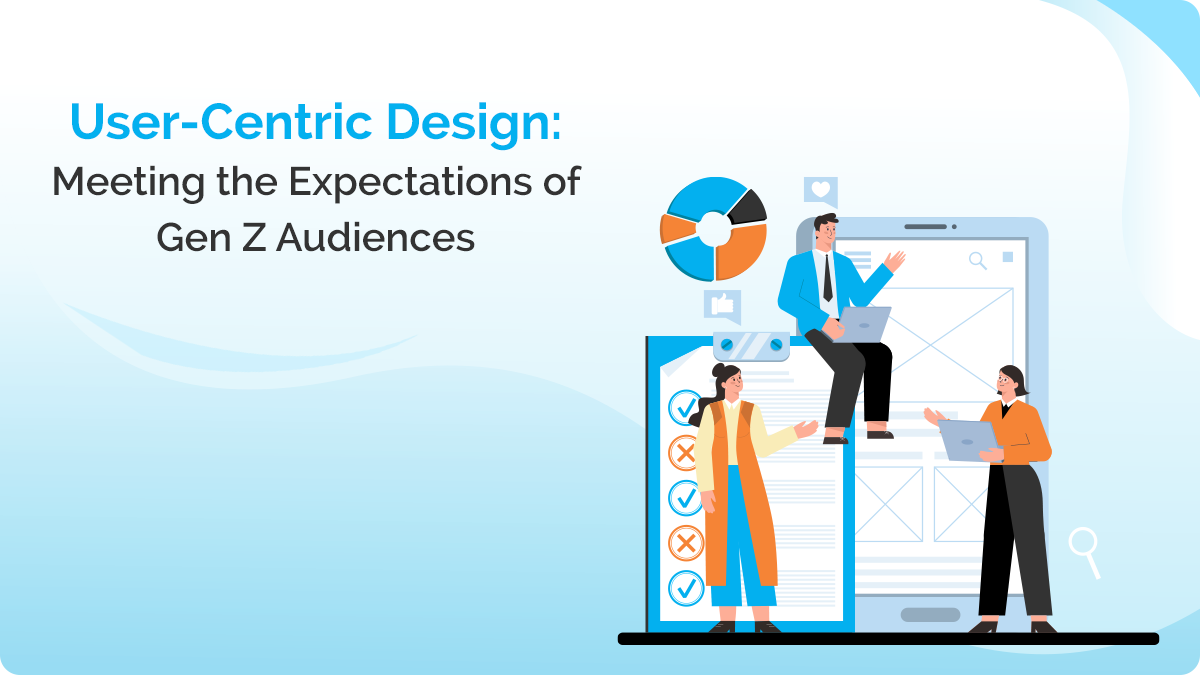In the rapidly evolving landscape of digital experiences, catering to the needs and expectations of diverse audiences is paramount. Among the most influential and tech-savvy demographic groups today is Generation Z. Born between the mid-1990s and early 2010s, Gen Z represents a generation that has grown up surrounded by technology and is characterized by its unique preferences and behaviors. To successfully engage and capture the attention of Gen Z, businesses and designers must adopt a user-centric design approach that aligns with their expectations.

Understanding Gen Z: Digital Natives with Distinct Preferences
Gen Z is often referred to as “digital natives” due to their early and constant exposure to digital technologies. This exposure has shaped their behaviors, communication styles, and expectations, especially in the realm of user experience. To create designs that resonate with Gen Z audiences, it’s crucial to understand their distinct preferences:
1. Mobile-First Mentality:
Gen Z predominantly uses smartphones for various activities, from socializing to shopping. Designing with a mobile-first mindset ensures that user interfaces are intuitive and visually appealing on smaller screens.
2. Visual Engagement:
Visual content is key to capturing the attention of Gen Z. Incorporating engaging visuals, such as videos, GIFs, and interactive elements, enhances the overall user experience and encourages longer engagement with digital platforms.
3. Personalization and Authenticity:
Gen Z values personalized experiences and authenticity. User-centric designs should incorporate features that allow for personalization, such as tailored recommendations and customizable user profiles, fostering a sense of connection and relevance.
4. Instant Gratification:
Growing up in an era of instant information, Gen Z expects quick and seamless interactions. Designs should prioritize fast loading times, easy navigation, and instant access to relevant content or services.
5. Social Connectivity:
Social media plays a significant role in the lives of Gen Z. Integrating social sharing features and creating opportunities for user-generated content can enhance the social aspect of the user experience.
Read more: Creating a Winning Content Calendar for Social Media
The Role of User-Centric Design in Meeting Gen Z Expectations
User-centric design is an approach that prioritizes the needs, preferences, and behaviors of users throughout the design process. When applied to cater to Gen Z audiences, it becomes a powerful tool for creating digital experiences that resonate and drive engagement.
Here’s how user-centric design principles can be effectively applied to meet the expectations of Gen Z:
1. Empathetic Design Thinking:
Understanding the unique challenges, aspirations, and values of Gen Z is fundamental to empathetic design. Conducting user research, surveys, and interviews can uncover valuable insights that shape the design process.
2. User Persona Development:
Creating detailed user personas specific to Gen Z allows designers to visualize and prioritize features that align with their preferences. These personas serve as a reference point throughout the design and development stages.
3. Iterative Prototyping:
User-centric design involves an iterative process of prototyping and testing. By creating prototypes early in the design phase and gathering feedback from Gen Z users, designers can refine and enhance the user interface based on real-world insights.
4. Responsive Design for Multi-Platform Accessibility:
Gen Z seamlessly transitions between devices, so ensuring a consistent and responsive design across various platforms is crucial. This approach guarantees that the user experience remains cohesive and enjoyable, regardless of the device used.
5. Incorporating Gamification Elements:
Gamification elements, such as badges, rewards, and interactive challenges, can enhance engagement among Gen Z users. This approach not only makes the user experience more enjoyable but also taps into their affinity for gaming and competition.
6. Accessibility and Inclusivity:
User-centric design goes beyond aesthetics; it prioritizes accessibility for all users. Considering diverse abilities and needs ensures that Gen Z audiences, regardless of individual differences, can navigate and interact with digital platforms seamlessly.
7. Continuous Feedback Loops:
The preferences and expectations of Gen Z are constantly evolving. Establishing continuous feedback loops, through surveys, analytics, and user reviews, enables designers to adapt and evolve digital experiences to align with changing trends and expectations.
Read more: The Impact of Chatbots in Modern Digital Marketing
Case Studies: Successful User-Centric Designs for Gen Z
1. Snapchat:
Snapchat’s ephemeral nature and focus on visual communication align perfectly with Gen Z’s preferences for instant, visual, and authentic content. The platform’s user-centric design continually introduces features based on user behavior and feedback.
2. TikTok:
TikTok’s algorithm-driven content discovery, short-form videos, and engaging challenges have made it a global phenomenon among Gen Z. The app’s user-centric design prioritizes personalized content delivery, fostering a highly engaging and addictive user experience.
3. Nike Training Club App:
Nike’s Training Club app employs a user-centric approach by offering personalized workout recommendations, progress tracking, and social features. The app’s design caters to Gen Z’s interest in health and wellness while providing a tailored experience.
Conclusion: Designing for the Future
As Gen Z continues to shape the digital landscape, businesses and designers must embrace a user-centric design philosophy to meet and exceed their expectations. By understanding the unique preferences of Gen Z, incorporating empathetic design thinking, and leveraging continuous feedback loops, digital experiences can be crafted to resonate with this influential demographic.
In the ever-changing world of technology, user-centric design is not just a trend; it’s a fundamental approach that ensures digital platforms remain relevant, engaging, and accessible to the audiences of today and tomorrow. As we design for Gen Z, we’re not just meeting their expectations; we’re shaping the future of user experiences in the digital age.
We are Atlanta’s Most Acknowledged Digital Marketing Agency
In today’s digital age, your social media presence is your storefront to the world. USSLLC is dedicated to helping you shine in this digital storefront, offering services that encompass content creation, community management, paid advertising, and more. Our goal is simple: to help you boost your brand’s visibility, grow your audience, and increase your ROI.
So, if you’re looking to make a real impact on social media and unlock the full potential of your brand, look no further than USSLLC, Atlanta’s most acknowledged digital marketing agency. Let’s embark on a journey to elevate your social media game and take your brand to new heights.
Contact us today and witness the transformative power of effective digital marketing. Your success is our priority!
